Cultural Resources
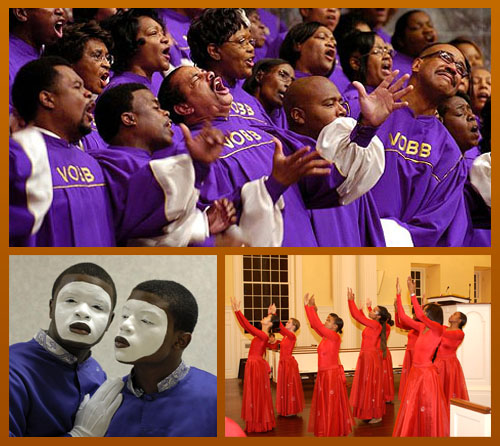
WORSHIP AND ARTS SUNDAY
(Formerly known as Choir Anniversary Sunday)
CULTURAL RESOURCES
Sunday, September 22, 2013
Tammy L. Kernodle, Guest Cultural Resource Commentator
Professor of Musicology, Miami University
Scriptures: Psalm 149:1-4, Psalm 20:1-5, and Psalm 33:1-4
I. The History/Historical Documents Section
Within the spectrum of Black Christianity the practice of worship has taken on different meanings since the first all-black congregations began to appear in the Southern colonies during the Antebellum period. Although practices have evolved from the congregational singing styles that developed out of these early religious gatherings, the corporate act of worship remains a common trope in the life of African Americans and the Millennial Black Church.
Today worship extends beyond the singing of the choir and the instrumental worship of the musicians to also include multiple forms of praise dancing, gospel miming, holy hip-hop, stepping, and what some call performance art (primarily spoken word performances). The religious roots for African American worship in song and dance can be found in the Old Testament. The concept of worship through song is first introduced in the fifteenth chapter of Exodus when the children of Israel witness the miracle of God parting the Red Sea and subsequently destroying Pharaoh and his army. Moses first engages the Israelites in singing a song of praise (vv. 1-18) and later Miriam, the sister of Aaron, praised God with the timbrel and dance (vv. 20-21).
Throughout the Old Testament, the wonders and miracles of God were responded to with corporate praise. Worship was so central to the covenant between God and his people that He not only designated a specific tribe of people to lead the others into worship (Levites; see Numbers 3), but God also defined the type of worship that should take place in the temple. The eclectic nature of this worship—dancing, singing, and the playing of instruments—has been reflected in the practices of the Black Church since its beginnings, and these same practices were brought to the Americas by our enslaved foreparents who danced, sang, and played instruments as part of their everyday cultural formation, especially in west Africa.
Black Song Traditions and the Black Church
In the praise houses, brush harbors, and "secret places" that framed the early worship services of African Americans, various song practices developed. Since most blacks could not read and in many instances it was illegal for them to do so, these early practices relied heavily on call-and-response in order to sustain corporate worship, and the melodies and texts drew on every available source—hymns sung by white Protestants during the Second Great Awakening, spirituals that slaves crafted out of their understanding of the Bible and God, and African melodies that had been retained and passed down. Despite the diversity of structure and form that each of these song forms reflected, each articulated a theology of transcendence that governed the lives of these people. The black sacred song became central in the survival of black people through all of the social, economic, and political influences that framed black life through Emancipation, migration, and segregation.
Although there were marked differences between black church practices in the South and the North, music constituted a larger portion of the worship experience in both locations. Many northern congregations began to advance the arranged spiritual, anthem, and the sacred works of European composer such as Bach and Handel during the late 19th and early 20th centuries. The choir increasingly became the important conduit for worship as the 20th century progressed and music ministries came to include multiple choirs performing varied repertoires. The gospel song, as defined first by the compositions of Charles Tindley, Lucie Campbell, and Thomas Dorsey, slowly became a popular song form in many black churches alongside long meter hymns, anthems, and congregational songs.
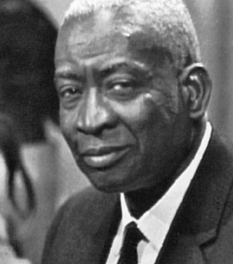 Thomas A. Dorsey |
The popularity of the gospel song corresponded with the emergence of the gospel choir, the first of which was organized in 1931 by Thomas A. Dorsey and Theodore Frye at the Pilgrim Baptist Church in Chicago.1 Although the gospel group and quartet remained the dominant group aesthetic during the recorded history of the Golden Age of Gospel (1945–1965), in the late 1960s the gospel choir became more prominent.
The evolution of the gospel choir was precipitated largely by the work of Mattie Moss Clark (1925–1994) and James Cleveland (1932–1991). Clark, mother of the famed singing group The Clark Sisters, modernized the performance aesthetic of the choir through her work as the International President of Music Department for the Church of God in Christ (COGIC) denomination. She revolutionized the gospel choir and her influence stretched well beyond her recordings with the Southwest Michigan State Choir as she mentored a number of musicians who would come to define the contemporary gospel sound, including Walter and Edwin Hawkins, Andraé Crouch, and Vanessa Bell Armstrong.2 |
Clark's work extended out of her role in the COGIC denomination, while James Cleveland's work with choirs stretched across multiple denominations. In addition to multiple recordings with choirs throughout the 1970s, 1980s, and early 1990s, Cleveland's most enduring legacy is the Gospel Music Workshop of America, which has focused on the performance, promotion, and preservation of gospel music.3 Both inspired a new generation of choir directors and songwriters including Hezekiah Walker, Rickey Dillard, Richard Smallwood, Kirk Franklin, and Donald Lawrence, who furthered the popularity of the mass or gospel choir in the late 20th century. The evidence of this influence can be seen in the repertory and performance approaches used by choirs every Sunday morning.
The late 1990s also marked the emergence of praise and worship teams in many black churches. The concept of praise and worship was first used in contemporary white church services during the 1970s. It is defined by small ensembles ranging from 3–7 members, accompanied by a range of instruments from only a piano to praise bands who engage the congregation in singing songs that precipitate energetic but also reverent praise. The text of the songs, which are generally simple to sing and in which verses or refrains are recited over and over, is either projected on a large screen or printed in church bulletins.
Praise and worship grew in popularity in contemporary white evangelical churches and was mass-mediated through the recordings of artists such as Twila Paris and Keith Green.4 Black musicians also began to transition to this style in the 1980s, most notably Andraé Crouch and Thomas Whitfield.
 |
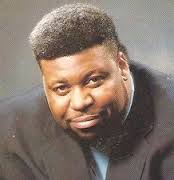 |
|
Andraé Crouch |
Thomas Whitfield |
But praise and worship really became popular among black congregations through the recordings of Judith Christie McAllister, Israel Houghton, Joe Pace, and Fred Hammond in the late 1990s and early 2000s. Songs such as "Highest Praise" (Pace), "Blessed" (Hammond), and "We Worship You" (Houghton) have replaced the traditional lining out hymns or devotional songs such as "I'm a Soldier (in the Army of the Lord)" in many churches. The popularity of praise and worship has not only marked changes in repertory but also practice as many congregations have replaced the traditional devotional services led by the deacons with 30–40 minutes of praise and worship.
Some congregations have adapted the praise and worship format as the core form of musical worship in lieu of the traditional choir and chorus. This has prompted a shift in the personnel comprising some music ministries, as choir directors have given way to worship leaders who are now responsible for the selection of songs and the leading of congregation, singers, and musicians in worship. The popularity of this type of aggregation has also given birth to new song styles and also diversified the context of corporate worship on Sunday mornings.
Dance in the Black Church
Sacred dance has been a facet of the worship practices of African Americans since these cultural expressions have been documented. Where the song represented the vocalization of praise, dance reflects the physical manifestation of praise. In the praise houses of the early African American religious experience, the ring-shout served as one of the examples of the symbiotic relationship between music and movement within traditional African worship practices. But the ring-shout constituted only one facet of sacred dance in the early church; "shouting" or the embodied response to the movement of the Holy Spirit was also an important facet of worship.
In the late 20th century, new forms of dance began to appear within the context of worship. Dance in this new form has taken on many different connotations and representations. One example is the flag/banner ministries, which does not include the engagement in physical dance but in the waving of colored flags or banners (which have specific meanings) throughout the worship service in order to facilitate the movement of the Spirit.
The most common form of sacred dance is liturgical dance, which was first introduced to worship services in the 1970s. This type of dance draws on modern, jazz, and Afro-Caribbean dance styles. Many attribute the integration of this practice into worship services to two major influences. First was the popularity of modern dance styles advanced by Alvin Ailey, most notably his religious dance tome "Revelations" and Arthur Mitchell's Dance Theater of Harlem. The second was the emergence of the Sacred Dance Guild and its involvement with black congregations during this period. Started in 1958, The Sacred Dance Guild (SDG) was significant in the resurgence of sacred dance practices in Protestant and Catholic denominations. The Guild diversified its scope in the 1970s and 1980s to include modern, African, and other ethnic traditions, and many of its members began to create the first liturgical dance troupes in black churches.5
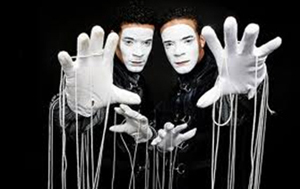
The growing popularity of liturgical dance over the past twenty years in black churches has sparked much debate about the role of dance in worship practices, but many have viewed this as an important and vital part of the worship experience. One of the most recent forms of dance to emerge in black congregations is mime, which is also referred to as gospel mime. This ministry draws from pantomime traditions that involve the acting out of texts or songs with body motions and facial expressions. Practitioners typically paint their faces in the white makeup that has defined the secular tradition. The practice was formally introduced to black worship services in the late 1980s by brothers Karl and Keith Edmonds, commonly known as K&K Mime. They have been showcased by such gospel luminaries as Dr. Bobby Jones, Kirk Franklin, and Donnie McClurkin, and are now identified as the "Godfathers of Gospel Mime."6
The ministry of the Edmonds brothers has provided the blueprint for numerous gospel mimes. It should also be noted that the incorporation of mime in worship services has also challenged the gendered aspects of who dances in what way in the church, as males dominate this genre and females dominate most of the other genres. Other churches have also integrated step teams and Holy Hip Hop dance teams into their youth ministries as a means of offering new ways for young people to express themselves. All of these ministries point to the various ways in which contemporary congregations have sought to expand the context of worship and reconnect with African practices that married music and worship with movement.
Instrumental Worship in the Black Church
Since the days of the early temple in the Old Testament, the worship of God with instruments has been an important facet of worship. While trumpets, timbrel, and harps are often referenced in early practices, today the Hammond organ, piano, and in some churches various keyboards, horns, drums, and electric bass frame the most common forms of instrumental worship. Worship through instruments extends beyond simply accompanying choirs, congregational singing, and the pastor. Long before the first notes are sung, or the first Scripture or prayer is offered, the instruments set the atmosphere for worship. Instrumental interpretations of hymns and/or well-known gospel songs serve as the prelude to worship, but throughout the service musicians are instrumental in facilitating the movement of the "Spirit," transitioning from one moment to the next and shaping the overall tone of the service. Too often one can overlook the importance of instrumental worship, but it has proven to be one of the most influential factors in establishing and progressing the flow of the worship service.
II. Biographical and Autobiographical Stories/Personal Testimonies
Mattie Moss Clark (1925–1994) and the Development of the Modern Gospel Style
 |
The evolution Born in 1925, Mattie Moss was raised in the Methodist Church and began piano lessons at age six. She attended Selma University for one year before relocating to Detroit to live with a sister. Within a year of her arrival, she discovered the Church of God in Christ (COGIC), joined the church, and became director of the choir at Bailey Temple COGIC. Her compositional and musical abilities led to her appointment as the music director of the Southwest Jurisdiction of COGIC. She later became the international president of the denomination's music department, through which she mentored a number of talented singers and musicians, including Rance Allen, Vanessa Bell Armstrong, and Walter Hawkins. Clark was the dominant force behind the choir movement in the COGIC denomination and is credited with introducing intricate and innovative performance approaches to gospel arrangements. In 1958, she became one of the first to record a gospel choir and in her lifetime she penned more than seven hundred songs, recorded twenty albums, and dramatically shaped harmonic and vocal practices in gospel music. She was central in shaping the repertory of the COGIC denomination until her death in 1994. |
James Cleveland (1932–1991)
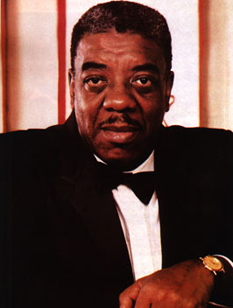 |
Commonly referred to as the "Crown Prince of Gospel Music," James Cleveland first came to prominence through his work with the legendary gospel group The Caravans. He is generally viewed as an important link between the traditional gospel sound and the evolving early contemporary gospel style of the 1970s. In 1967, he founded the Gospel Music Workshop of America (GMWA), which continues to be one of the leading organizations devoted to the genre, producing notable performers such as John P. Kee and Kirk Franklin. In addition to the GMWA, Cleveland's work as editor of the songbook Songs of Zion helped shaped the concept of modern black hymnody. It contains Cleveland's arrangements of hymns, spirituals, and gospel songs and also contains a comprehensive guide to effective gospel vocal and instrumental performance. As a composer and arranger he also contributed a number of songs that became standards in the repertory of gospel choirs—"Peace Be Still," "I've Been in the Storm Too Long," and "Lord Do It for Me." |
My Personal Story
I've had the unique opportunity to serve in various capacities within the Black Church. For over thirty years, I've spent my Sunday mornings either seated behind a piano, leading a congregation in praise and worship, or directing a choir. I've worked in numerous churches in almost every conceivable denomination, but the most profound experience I've had was during my tenure at the First Baptist Church in Oxford, Ohio. Located west of Dayton, Ohio, and about 35 miles north of Cincinnati, Oxford is a small town with a rich cultural past. When I arrived there in 1997, I had very little knowledge of the city or that it had been a major point of migration for many leaving Mississippi and Alabama during the World War II years. Most of all I had no idea that the few black churches that were located in Oxford had been great incubators of black cultural traditions.
I began attending the First Baptist Church shortly after arriving in Oxford. Although I was reared in the South, I had only heard long meter hymns on the records I checked out at the music library while a student at Ohio State University. But on that first Sunday, I came in contact for the first time with a diversity of black sacred music. The service started with the traditional devotional service. The deacons arranged themselves at the front of the church and one read a Scripture and then another gave a prayer. Then Deacon Jimmie Brown started lining out the song "I Love the Lord He Heard My Cry." The congregation, young and old, instinctively fell right into the song and before long that little church was filled with sound. He sang verse after verse and everyone followed. The rest of the service was filled with everything from devotional songs such as "Can't Nobody Do Me Like Jesus" to gospel songs performed by the choir. Sunday after Sunday for the first ten years I was living and worshiping in Oxford this scene was repeated.
But as those deacons and church members got older and transitioned from this world, the devotional service gave way to new songs. Over the years, I transitioned from simply being an observer to a participant. Although I initially eschewed the role of pianist or Minister of Music, in time the Pastor convinced me that my talents were to be used by God in this way. In 2011, I took a leave of absence from First Baptist to pursue a teaching fellowship at another university in another state. But as I sat at the piano for what would be my last Sunday as Minister of Music, I reflected on what I had learned over the years. Deacon Jimmie Brown and the other senior members of that congregation had taught me valuable lessons over the years.
The first is that progress is okay, but never discard the great traditions of the past. Even with my love for the contemporary gospel songs of Donald Lawrence, Kirk Franklin, and groups such as Youthful Praise, every Sunday I tried to include hymns and the traditional devotional songs of the previous generation. I unfortunately did not master the practice of long meter hymns, but I one day hope to, and I will try wherever I am to stress its importance to the next generation of musicians.
The second lesson is that music is an important ministry and every song, note, and nuance should be about praise and not entertainment. A music ministry can set or destroy the atmosphere of a service, so one should be focused on the move of the "Spirit" and not what would spotlight an individual.
The third lesson is that praise is not just sung but can be embodied through movement. I had never had any experience with praise dancing before First Baptist, and over the years the liturgical dance team and choir collaborated and performed together. I do not believe there is anything more transformative that seeing hands, feet, bodies, voices, and instruments used in corporate praise to God. My thinking and approach to music ministry radically changed during my tenure at First Baptist Church, and I am grateful for the time that had at that little church in Southwestern Ohio. I came to realize during that period of my life that when the ministries of music and movement work in tandem with the ministry of the Word, lives can be transformed and the world around you can be changed.
III. Resource and Excerpts
- Glenn Hinson's Fire in My Bones: Transcendence and the Holy Spirit in African American Gospel (Philadelphia: University of Pennsylvania, 2000) contains many stories drawn from his ethnographic study of a single gospel program that brings together a particular set of musicians and vocalists.
- Consider the following excerpt from When Malindy Sings by Paul Laurence Dunbar:7
Who dat says dat humble praises, wif de Master nevah counts?
Heish yo' mouf, I hyeah dat music, ez hit rises up an' mounts—
Floatin' by de hills an' valleys, way above dis buryin' sod,
Ez hit makes its way in glory to de very gates of God!
- Excerpt from "A Wonderful Choir" by Connie Campbell Bratcher:8
"The message of a choir singing out
In joyful worship and praise,
Is a glorious anchor for our souls
In the stormy, turbulent days."
IV. Songs That Speak to the Moment
Anthem of Praise
by Richard Smallwood
(Tenors)
Praise Him with the timbrel and dance
Praise Him with the sound of the trumpet
Praise Him with the psaltery and harp
Let everything that hath breath praise the Lord
(Tenors & Altos)
Praise Him with timbrel and dance
Praise Him on the high sounding cymbals
Oh praise Him with string instruments
(Tenors)
Let everything that hath breath praise the Lord
(All)
Oh magnify the Lord, magnify the Lord with me
Magnify the Lord, Oh magnify the Lord with me
Magnify the Lord, magnify the Lord with me
Magnify the Lord
Let us exalt His name together
(Tenors)
Praise Him with the timbrel and dance
Praise Him with the sound of the trumpet
Praise Him with the psaltery and harp
Let everything that hath breath praise the Lord
(Altos & Sopranos) / (Tenors)
Praise Him / Praise Him with the timbrel and dance
Praise Him / Praise Him with the sound of the trumpet
Oh Praise Him / Praise Him with the psaltery and harp
Let everything that hath breath praise the Lord
(All)
Oh magnify the Lord, magnify the Lord with me
Magnify the Lord, Oh magnify the Lord with me
Magnify the Lord, magnify the Lord with me
Magnify the Lord
Let us exalt His name together
(Tenors)
Oh be joyful all ye people and clap your hands
Oh be joyful all ye people and clap your hands
(Tenors & Altos)
Oh be joyful all ye people and clap your hands
Oh be joyful all ye people and clap your hands
(All in counterpoint)
Oh be joyful all ye people and clap your hands
Oh be joyful all ye people and clap your hands
(Rounds)
Oh, Oh, Oh Praise Him
Sopranos
Praise His Name
Lift Him up
Lift Him up
Lift Him up
Lift Him up
(Sopranos)
Higher and Higher
(Tenors)
Let everything that hath breath praise Him
(Tenors & Altos)
Let everything that hath breath praise Him
(Tenors & Altos & Sopranos)
Let everything that hath breath praise Him
(All)
Let everything that hath breath praise The Lord!9
More Than Anything
by Lamar Campbell
I lift my hands in total admiration unto you
You reign on the throne
For you are God and God alone
Because of you my cloudy days are gone
I can sing to you this song
I just want to say that I love you more than anything
You hold me in your arms
You are my shelter from the storm
When all my friends were gone
You were right there all along
I never known a love like this before
I just want to say that I love you more than anything
I love you Jesus
I worship and adore you
Just want to tell you
Lord I love you more than anything10
The Reason Why I Sing
by Kirk Franklin
Verse 1:
Someone asked the question why do we sing?
When we lift our hands to Jesus what do we really mean?
Someone may be wondering when we sing our song
At times we may be crying and nothing's even wrong
Chorus:
I sing because I'm happy, I sing because I'm free
His eye is on the sparrow that's the reason why I sing
Glory hallelujah. You're the reason why I sing
Glory hallelujah. I give the praises to You
Glory hallelujah. You're the reason why I sing
Verse 2:
And when the song is over, we've all said Amen
In your heart just keep on singing and the song will never end
And if somebody asks you was it just a show
Lift your hands and be a witness and tell the whole world no.
And when we cross that river to study war no more
We will sing our songs to Jesus the one that we adore
Chorus11
V. Audio Visual Aids
- For images of the music practices of the church, see Soul Sanctuary: Images of the African American Worship Experience. For more information about this exhibit and samples of the images contained in the exhibit, see http://www.soulsanctuarybook.com/images/ss_exhibitspecs.pdf.
- Video resource on early Black Sacred traditions: McIntosh County Shouters (features examples of the ring-shout and other traditional song/dance practices):

- For a discussion of the role of worship leaders in contemporary churches, see Hamil R. Harris, "In the Life of the Church, Praise and Worship Leaders Play a Key Role," March 30, 2012; online location: http://articles.washingtonpost.com/2012-03-30/local/35446333_1_praise-and-worship-worship-leader-choir-director.
- Video resource on Praise and Worship: Judith McAlister's "Worship the Lord":

- Judith McAlister's advice for worship leaders:

- An excerpt on the history of dance in the Black Church by Sylvia D. Bryant:
Black Sacred Dance, as a formal and acknowledged expression, does have a very distinct history. The Hampton Institute organized a creative dance group and dance spiritual for the first time in 1925. Since this time, sacred Dance, using the Black expression, has been limited to theatre and concert halls. Many famous dance artists such as Joe Nash, Pearl Primmus, and Talley Beatty performed religious works. Arthur Mitchell and Alvin Ailey have choreographed significant dance works. Alvin Ailey's Revelations have been accorded world fame. "To experience Ailey's dynamic suite of spirituals is like being in church," one enthusiast suggested.
(Source: Sylvia D. Bryant, Sacred Dance Journal, vol. 23 #1 1980; online location: http://www.sacreddanceguild.org/pdfs/articles/blackchurch.pdf)
- Video example of Liturgical dance: "Set the Atmosphere":

- Video Interview of K&K Mime on BET (discusses the origins of their ministry and their mission as ministers of the Word through dance):

- K&K Mime performing to Donnie McClurkin's "Stand":

- Video of a Gospel Step Team—DOC Step Team:

VI. Books to Enhance Your Understanding of Music, Dance, and Instrumental Worship
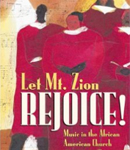 |
Abbington, James. Let Mt. Zion Rejoice! Music in the African American Church. Valley Forge, PA: Judson Press, 2001. |
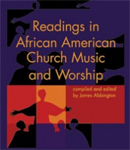 |
Abbington, James. Readings in African American Church Music and Worship. Chicago: GIA Publications, 2001. |
 |
Adams, Stephanie Butler. My Body Is the Temple: Encounters and Revelation of Sacred Dance and Artistry. Fairfax, VA: Xulon Press, 2002. |
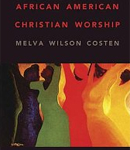 |
Costen, Melva Wilson. African American Christian Worship. Nashville, TN: Abington Press, 2007. |
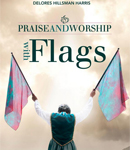 |
Harris, Patricia Hillsman. Praise and Worship with Flags: Waging Spiritual Warfare in the Church and Home. Bloomington, IN: WestBow Press, 2011. |
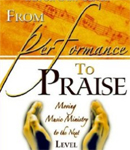 |
Pace, Joe. From Performance to Praise. New York, NY: Serenity Publishing and Communication, 2004. |
Notes
1. Boyer, Horace. "Thomas Dorsey: Father of Gospel Music." Black World, July 1974, 24.
2. Kernodle, Tammy. "Work the Works: The Role of African America Women in the Development of Contemporary Gospel," Black Music Research Journal, vol. 26, no. 1, Spring 2006, 97–99.
3. Maxille, Horace. "James Cleveland." Encyclopedia of African American Music, vol. 1: A–G, Emmett Price, Tammy L. Kernodle, and Horace Maxille, Jr., eds. (Santa Barbara, CA: Greenwood Press, 2011), 208.
4. Pollard, Deborah Smith. When the Church Becomes Your Party: Contemporary Gospel Music (Detroit, MI: Wayne State University Press, 2008).
5. "History of the Sacred Dance Guild." Online location: http://www.sacreddanceguild.org/ (accessed March 20, 2013).
6. "Interview with K&K Mime." Online location: http://www.blackgospel.com/interviews/kandkmime/ (accessed March 21, 2013)
7. Dunbar, Paul Laurence. When Malindy Sings (New York, NY: Dodd Mead and Co., 1903).
8. Bratcher, Connie Campbell. "A Wonderful Choir." Online location: http://faithpoetry.com/faith4/awonderfulchoir.shtml (accessed March 20, 2013).
9. Anthem of Praise. By Richard Smallwood. Richard Smallwood with Vision: Persuaded—Live in D.C. New York, NY: Verity, 2001.
10. More Than Anything. By Lamar Campbell. When I Think about You. Brentwood, TN: Chordant, 2000.
11. The Reason Why I Sing. By Kirk Franklin. Kirk Franklin and the Family. Inglewood, CA: Gospocentric, 1998.



